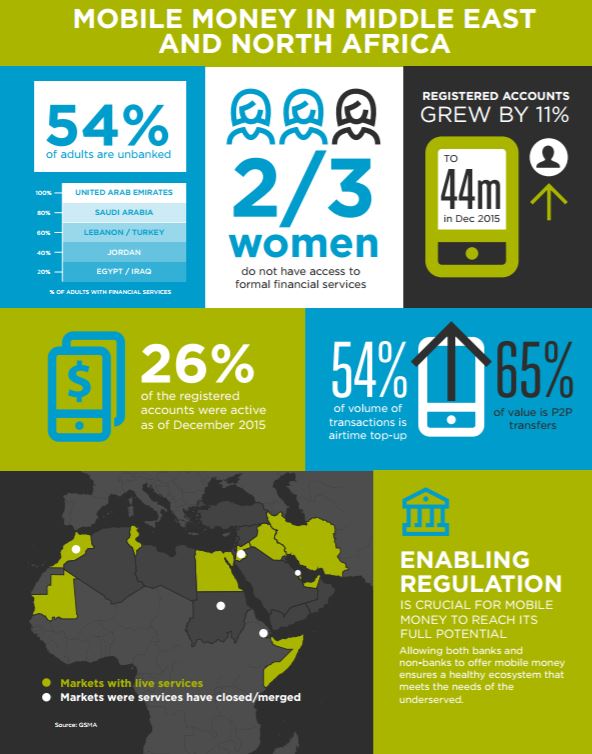Over 60% of the population is financially excluded in the Middle East & North Africa (MENA)—a higher proportion than all regions except for Sub-Saharan Africa, where two-thirds of the population are unbanked. Aside from Iran, in all developing countries in the region more than half of the population are excluded from financial services.
New market launches
Mobile money services were first launched in the region in Somalia in 2009, and there are now 20 live services in 10 markets. In 2016, mobile money was introduced in two new markets: Iraq and Jordan:
- Zain Cash was launched in Iraq in February 2016 by Iraq Wallet, an authorised company from the Central Bank of Iraq (CBI). Through Zain Cash, customers can have a mobile money account linked to their SIM card, enabling them to make financial transactions easily and at any time. This is the second mobile money service to be launched in Iraq, following the introduction of AsiaHawala by Asiacell (Ooredoo) in January 2016 (also licenced by the CBI).
- At the beginning of 2016, Jordan became the first country in MENA to implement interoperability of mobile money services after the successful launches of Mahfazti in January, a mobile money service offered by a consortium of banks and operators called Al Hulool, and of Zain Cash in March. Both services are connected to JoMoPay, a central switch owned by the Central Bank of Jordan which enables cross-network transfers between the services as well as interoperability with the country’s broader payment infrastructure. These launches happened after the publication of the new regulatory framework for mobile money in December 2013.
Reaching scale in MENA
Mobile money is starting to reach scale in countries such as Egypt, where the regulator reported that there are more than five million mobile money accounts [1], double that of last year. However, driving customer usage remains a major issue across the region, with the exception of Somaliland where the level of mobile money adoption is particularly strong. In fact, Somalia is one of the few countries in the world where more adults reported having a mobile money account (37%) than an account at a formal financial institution (8%). One reason for this is the effort made by mobile money services in Somalia in building an active subscriber base, for both customers and merchants: Telesom ZAAD, for example, reports a more than 70% active subscriber rate (compared to 26% on average across the region), and more than 35% of Telesom’s subscriber base actively use the ZAAD service.
Regulatory changes in the region
Mobile money regulation has seen changes in several markets in MENA, encouraging growth in mobile money services.
- Following Morocco in March 2015, Tunisia voted for a new banking law in June 2016 that provides the foundations for establishing an enabling regulatory framework for mobile money. Specifically, these new banking laws introduce a new category of financial institution, payment service companies, which opens up the provision of mobile money services to non-banks. The new laws also provide a more flexible framework around the distribution of mobile money through agents.
- In Egypt, the regulator has also introduced inbound international remittances through mobile money services, allowing mobile money users to receive international transfers directly into their mobile money account.
These recent regulatory developments happen in the context of the growing interest from regulators in financial inclusion in the region. In April 2016, the Council of Arab Central Banks Governors decided to adopt an Arab Day of Financial Inclusion, demonstrating the commitment from financial sector regulators to accelerate financial inclusion in the region.
This article was published as part of GSMA 2016 edition of the Mobile Economy report for the Middle East and North Africa region (MENA).
Notes:
[1] Source: Central Bank of Egypt


